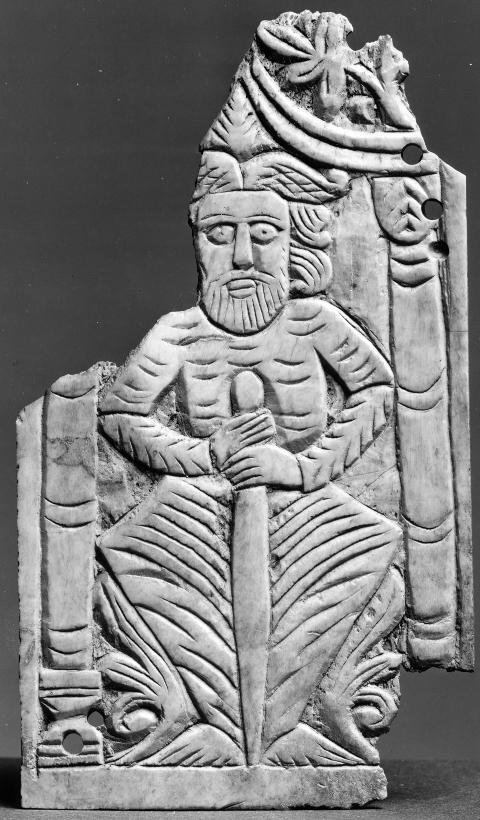|
|
Sasanian king carved in ivory, Egypt, c.619-639 CE.

A larger image of this Sasanian king carved in ivory, Egypt, c.619-639 CE. The Walters Art Museum 71.62
Seated King
A Sasanian king sits with his knees spread between two columns beneath a reversed arch.
He holds a sword with both hands and stylized plant forms emerge at his feet.
Some scholars suggest that the iconography of this image may have been transmitted through the influence of Persian textiles that entered Egpyt through trade and conquerors.
The carving was most likely rendered by an Egyptian carver during the Sasanian occupation of Egypt, from 619-639 CE.
Creator: Egyptian (Artist)
Period: 7th century
Medium: ivory
Accession number: 71.62
measurements: H: 6 15/16 x W: 3 7/8 in. (17.6 x 9.8 cm)
Geography: Egypt, Sohag (Place of Discovery)
Provenance: Dikran Kelekian, Constantinople and Paris [date of acquisition unknown], by purchase; Henry Walters, Baltimore [date of acquisition unknown], by purchase; Walters Art Museum, 1931, by bequest.
Source: Walters Art Museum 71.62
On a seventh-century bone carving in the Walters Art Gallery (Fig. 42), simple and crude in design, there is a frontal image of an enthroned king wearing a crown decorated with vague, winglike forms and superficially resembling that of a Sasanian king.115
The piece has been said to show evidence of Sasanian influence, but there is no indication of a couch throne.
A Coptic textile from Antinoë, repeatedly cited as Sasanian in style, has as part of its design an enthroned figure.116
The pose of the enthroned figure is admittedly the same as that on Sasanian works of art. He sits full-front, holding a sword between splayed legs, but neither his dress nor his throne seat in any way reflect Sasanian types.
115. Walters Art Gallery, Baltimore, acc. no. 71.62; height 17.6cm.; width 98cm. Provenance unknown, supposedly Sohag in Egypt: Ross, "A Coptic Bone Carving," p. 123. pl. I. Der Nersessian in a review of the exhibition catalogue Pagan and Christian Egypt describes this plaque as later than the seventh century: ArtB, p. 167; Pagan and Christian Egypt, p. 37, no. 107. Ghirshman compares the bone carving to the rock-crystal medallion on the cup in the Bibliothèque Nationale (P1. 33); Persian Art, p. 304 fig. 402.
116. Musée Historique des Tissus, Lyons, inv. no. 28.928; height 80 cm.; width 66cm. Ghirshman, Persian Art, p. 236, fig. 289; Koptische Kunst, p. 344, no. 368; Peirce and Tyler, L'Art byzantin 1, pp. 87 ff., pls. 55, 56; Francovich, "II concetto della regalità," p. 25. The fabric is said to be copied from Sasanian works.
Source: pp.120-121, Harper, Prudence and Meyers, Pieter Silver Vessels of the Sasanian Period. Volume One: Royal Imagery, The Metropolitan Museum of Art, Princeton University Press, New York, 1981
|
|

